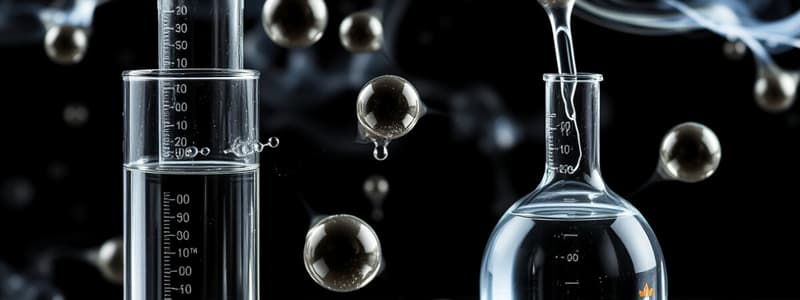Podcast
Questions and Answers
What happens to the molecular structure of a solid when it is heated?
What happens to the molecular structure of a solid when it is heated?
- The molecules vibrate more vigorously in place. (correct)
- The molecules become completely free to move.
- The molecules break apart into individual atoms.
- The molecules leave the solid and become gas.
Which process refers to the transition from gas to solid?
Which process refers to the transition from gas to solid?
- Melting
- Deposition (correct)
- Condensation
- Evaporation
In which state of matter do molecules have the least attraction to each other?
In which state of matter do molecules have the least attraction to each other?
- Liquid
- Gas (correct)
- Plasma
- Solid
What defines a liquid's volume and its inability to leave the container?
What defines a liquid's volume and its inability to leave the container?
What occurs during the process of melting?
What occurs during the process of melting?
Which property is unique to gases compared to solids and liquids?
Which property is unique to gases compared to solids and liquids?
What distinguishes compounds from elements?
What distinguishes compounds from elements?
Which of the following statements about solids is true?
Which of the following statements about solids is true?
Which of the following is an example of an element?
Which of the following is an example of an element?
What is the extent of compression for liquids compared to gases?
What is the extent of compression for liquids compared to gases?
Flashcards are hidden until you start studying
Study Notes
Matter
- Matter is anything that occupies space and has mass, including air, land, DNA, plants, animals, and objects.
- Exists in three states: solids, liquids, and gases, which can interconvert through heating or cooling.
Gases
- Fill the entire available space due to negligible intermolecular forces.
- Molecules are free to move and spread out, occupying the volume of their container.
Liquids
- Have no definite shape but retain a definite volume.
- Molecules are loosely packed, allowing flow but preventing them from escaping the liquid's surface.
- Heating liquids increases molecular kinetic energy, potentially transitioning them to gases.
Solids
- Retain definite shape and volume due to strongly packed molecules.
- Molecules vibrate in place but cannot move freely.
- Heating causes molecules to gain energy, potentially transitioning to a liquid state.
State Transitions
- Sublimation: Solid to gas (heating)
- Deposition: Gas to solid (cooling)
- Melting: Solid to liquid (heating)
- Freezing: Liquid to solid (cooling)
- Evaporation: Liquid to gas (heating)
- Condensation: Gas to liquid (cooling)
Differences Between States of Matter
- Intermolecular Space: Negligible in solids, slightly larger in liquids, maximum in gases.
- Force of Attraction: Maximum in solids, weaker in liquids, negligible in gases.
- Shape: Definite in solids, none in liquids and gases.
- Volume: Definite in solids and liquids, not in gases.
- Fluidity: Solids do not flow, liquids flow within their surface, gases flow in all directions.
- Compressibility: Solids cannot be compressed, liquids can be slightly compressed, gases can be highly compressed.
Elements
- Pure substances made of identical atoms that cannot be broken down.
- Examples include gold, silver, iron, and oxygen.
- Can exist in different physical states at room temperature: silver (solid), bromine (liquid), oxygen (gas).
Compounds
- Pure substances formed from two or more elements in fixed ratios.
- Cannot be separated by physical means; chemical methods are required for breakdown.
- Examples include water, carbon dioxide, and ammonia.
Properties of Matter
- Matter has mass and occupies space.
- Volume is the space that matter occupies.
- Demonstrated through simple experiments, indicating matter's mass and space-occupying qualities.
Composition of Matter
- Composed of extremely small particles called atoms.
- Atoms are the smallest units of elements showing element properties.
- Atoms combine to form molecules; molecules of different elements form compounds.
- Certain elements like helium and neon are unreactive and exist independently.
Molecules vs Atoms
- Atoms are the smallest units of matter without independent existence.
- Molecules can exist independently and exhibit properties of matter.
Structure of Atoms
- Atoms can be divided into protons (positively charged), neutrons (neutral), and electrons (negatively charged).
Arrangement of Molecules in States of Matter
- Solids: Tightly packed molecules, strong attraction, fixed shape, hard and incompressible.
- Liquids: Loosely packed, weak attraction, takes container shape, definite volume.
- Gases: Molecules far apart, negligible attraction, fill available space, highly compressible.
Intermolecular Forces of Attraction
- Cohesion: Attraction between identical molecules.
- Adhesion: Attraction between different molecules.
Observational Activities
- Experiment with balloons demonstrates that air occupies space and has mass.
- Water displacement activity shows that objects take up space in fluids.
Studying That Suits You
Use AI to generate personalized quizzes and flashcards to suit your learning preferences.




